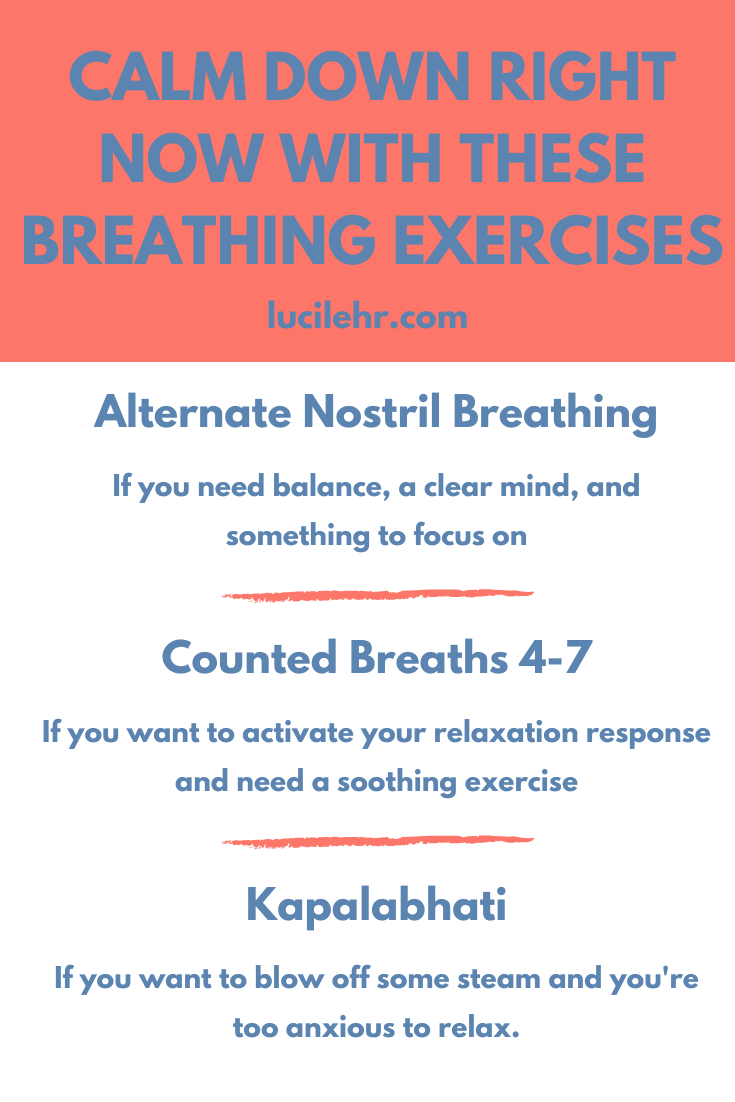The 3 Best Breathing Exercises for Anxiety to Calm Down Right Now
Going through tough situations is a normal part of life but if even the simplest things make you go into full-blown panic mode, keep reading! Over time, this anxiety spiral can have a negative impact on your mental health and daily life. While there are different breathing strategies for anxiety, there’s nothing simpler and more effective than quick breathing exercises to calm down.
Breathing is one of our most natural bodily processes - after all, we just breathe in and breathe out from day one. You could think that nothing could go wrong with inhaling and exhaling as our body does that on autopilot. You probably don't realize that the right calming breathing techniques can set you up for success with managing anxiety. You are going to breathe anyway, so why not use it as an anxiety management tool? Get ready to calm down and breathe!
Before getting into easy breathing exercises to calm your nerves, we will look into how anxiety impacts the breath and vice versa. I'll then give you the round-up on my favorite simple breathing techniques to calm down, targeted to what you need right now!
Table of Contents
Anxiety and Breathing: a Vicious Circle!
Have you noticed that when you are feeling anxious you are experiencing shortness of breath, your mind is racing and your heart is pounding? Say hello to your sympathetic nervous system! Its activation is why it’s hard to breathe when you are anxious or stressed.
Our nervous system consists of two parts: the sympathetic nervous system and parasympathetic nervous system. When you perceive a threat, the sympathetic nervous system activates, causing your cognitive system to shut down and react in three ways - either to fight, flight or freeze
The parasympathetic nervous system, on the other hand, is responsible for the feelings of ease and relaxation. Once this is activated, you can breathe more deeply, focus on your task, and act effectively as the brain is working perfectly. This is the rest-and-digest state we want to activate with breathwork!
So, can breathing help anxiety? Definitely yes! Breathing comes into the picture as it influences how your mind reacts. The way and pace in which you breathe, or being mindful of how you take in air and exhaling it changes the brain chemistry and brings your mind into a more relaxed state.
Don’t worry, you can learn how to calm down!
How to Reduce Anxiety With Breathwork
Conscious belly breathing is a simple way to reduce anxiety and promote relaxation in times of stressful situations. Being mindful of how you breathe and making sure you are taking deep belly breaths will help you tap into your parasympathetic nervous system by activating your vagus nerve. This calming breathing exercise will let you think more clearly and at the same time, leave anxiety behind!
When you’re feeling anxious, it’s hard to make sure you are breathing right but if you practice these easy anxiety breathing techniques for calming down, you’ll build up your resistance to stress triggers and to the fight-or-flight response. When you focus on the breath, you not only calm your mind but also your body.
Deep breathing is one of the best ways you can combat anxiety. When you take in deep breaths, the brain receives this as a message to relax. In turn, the body responds, eliminating those physical symptoms of increased heart rate, rapid breathing, and increased blood pressure as you move your way into relaxation mode.
If you're following me here: anxiety and breathing are very interconnected! Being anxious will have you take short breaths which in turn will make you feel more anxious. An easy way to break this circle is mindful breathing!
How to Get Into Mindful Breathing: Deep Belly Breaths.
As a mindfulness coach, I’m often asked “what are the best breathing techniques for anxiety?”: The first technique I teach is to solely focus on your breath - particularly the inhale and exhale while taking deep belly breaths.
The good thing about this yoga breathing technique is that you can do it wherever you are or whatever position you may be in - standing, sitting or lying. The important thing is to make sure you feel comfortable in your chosen position. You can also put one hand on your chest, one hand on your belly to make sure you are taking DEEP BELLY BREATHS. Did I stress that enough? Breathe with your belly, not with your chest.
You should dedicate some time to this easy calming breathing technique whether you are under stress or not. Don't wait until you are not feeling good to practice! If you consistently take mindful deep belly breaths, you’ll find that taming your fight-or-flight response gets easier and easier over time.
Best Breathing Exercises for Anxiety
Mindful deep belly breaths are only the starting point. There are other targeted calming anxiety techniques that I would like to share with you. I teach these a lot during my yoga and meditation classes as they are awesome tools to add to your own personal anxiety management tool kit!
These are my personal favorites:
1. Nadi Shodhana (Alternate Nostril Breathing)
In Yoga, Alternate Nostril Breathing is though to harmonize the two sides of the brain, bringing balance to your body and mind. I love it because it not only activates your relaxation response but it also gives you something to mindfully focus on as you'll need good coordination to do this technique! I personally use this anxiety breathing exercise to come back to calm when my mind is racing and I need to come back to a balanced and clear mind. This is also a good breathing technique for focus!
Here are a few easy steps:
Place your right thumb on your right nostril, blocking the air and start with an exhale from the left nostril
Inhale from the left nostril
Block the left nostril and exhale from the right nostril
Inhale from the right nostril
Block the right nostril and exhale from the left nostril
You're good to go! Repeat this on your own as much as you need. End on an exhale from your left nostril.
2. Counted breaths
Counting helps regulate your breathing. Basically, you are training yourself to take longer breaths. Counted breaths helps build your concentration and eliminate unwanted thoughts. It is one of the best exercise to relax almost instantly!
To do counted breathing, start inhaling, counting mentally up to 5. Exhale, to a longer count of 7. By exhaling longer, you are sending the brain a message to quiet down and then your body goes into relaxation for more clarity and focus. As you go on with this anxiety breathwork technique, you can go for a higher count.
This is a particularly soothing exercise to add to your evening routine, to cool down or to practice when you are feeling overwhelmed and need to calm your nerves. Practice it regularly and you’ll quickly learn how to calm your breathing on your own.
3. Kapalabhati (Skull Shining Breathing Technique)
If you're too anxious to relax, Kapalabhati is the way to go and lets you blow off some steam to prep your body and mind for relaxation. You can do this energizing technique before another anxiety breathing technique to put you in the right mindset.
Find a secluded or nonjudgmental place to practice it as it might look like you're having trouble breathing or just plain out weird to others who are not familiar with this technique.
To do it, strongly contract your lower belly, pushing air out of your lungs, as you exhale explosively. The inhale should be passive and will come naturally. Do a few cycles of 30 dynamic breaths using this technique.
As this is a more advanced calming exercise for anxiety, I recommend starting to practice it under the supervision of a trained teacher at first and stopping if you feel any discomfort. You should avoid this technique if you are pregnant or have high blood pressure.
Save the cheat sheet below with some easy breathing techniques to calm down!
I hope you enjoyed this article and left with some simple tools to manage anxiety. If you feel persistent anxiety, it might also be burnout: click on this article to learn how yoga can help!


